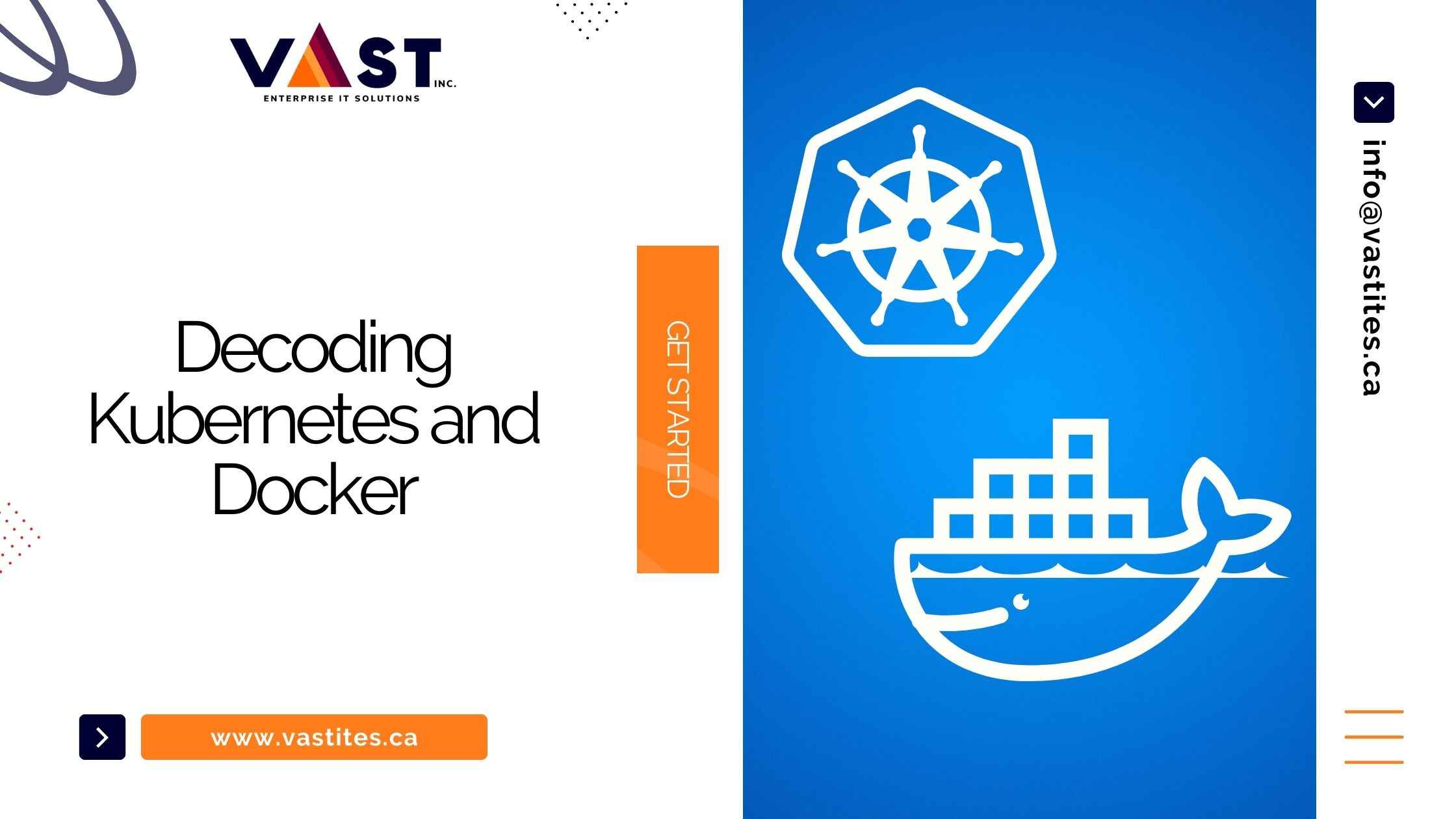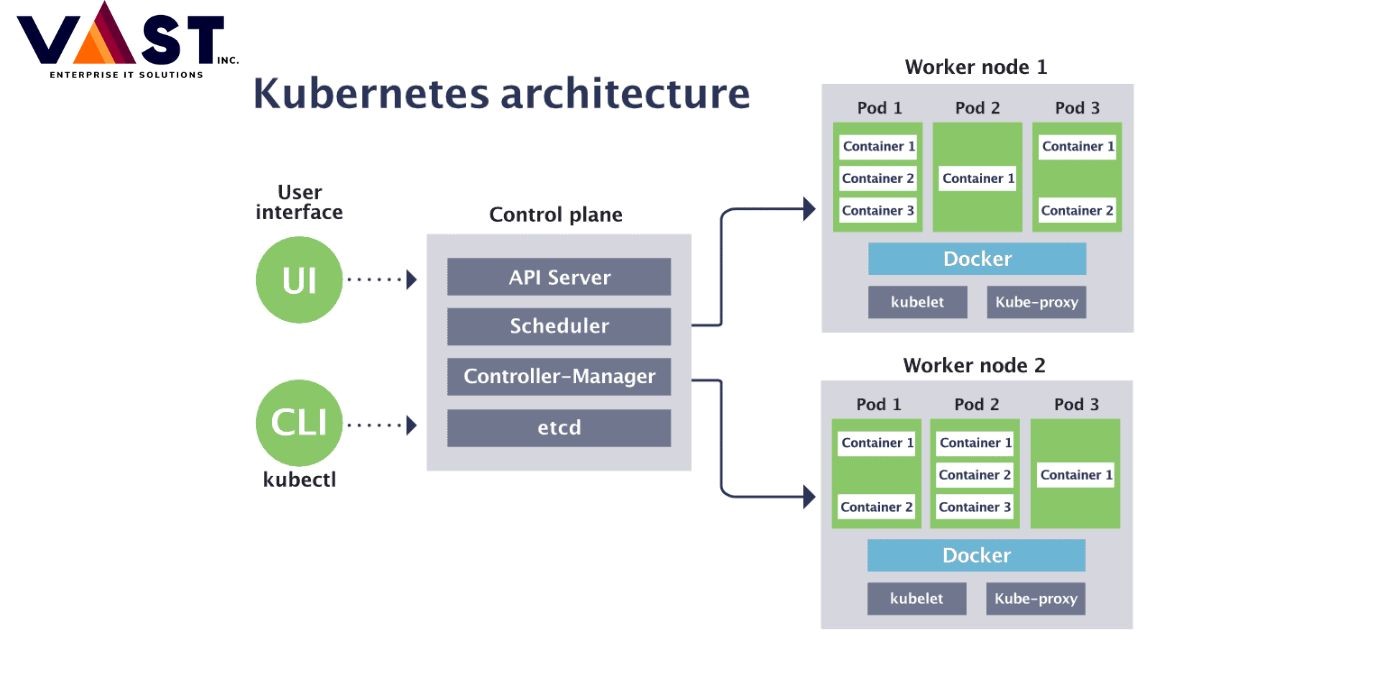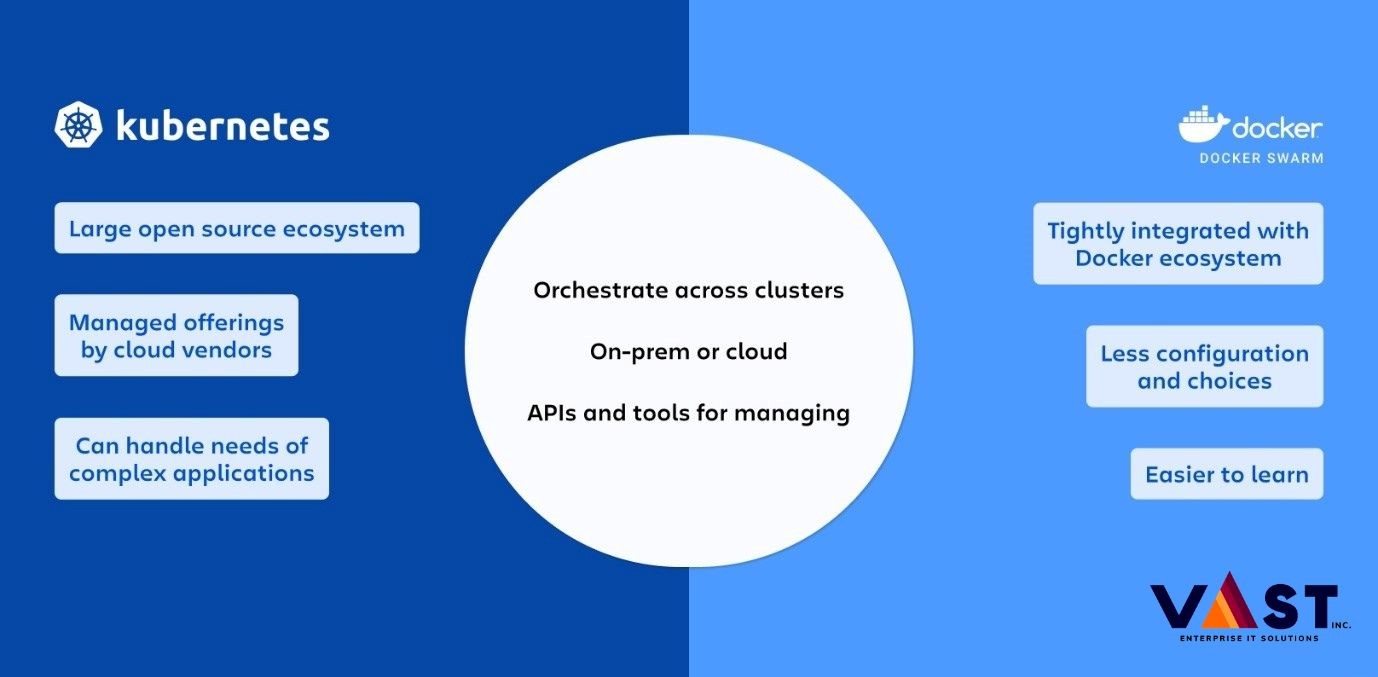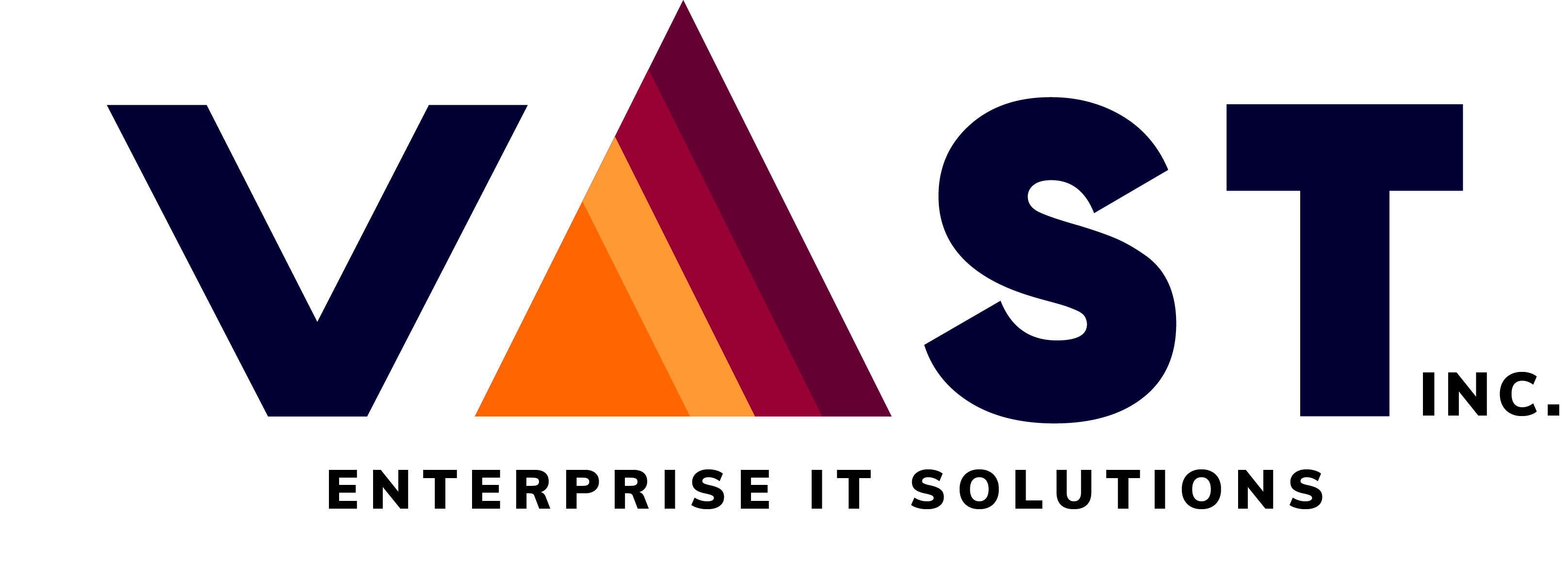
- November 22, 2023
- vastadmin
- 0
Introduction
In this evolving era, Kubernetes and Docker have come up as powerful and vital tools in the DevOps industry. In this blog, we will dive into what is Kubernetes and Docker and their components. We will also learn about the difference, benefits and challenges faced with Kubernetes and Docker. Let’s begin!
What is Docker
Docker is an open-source platform that automates the deployment of applications by packaging them in lightweight and portable containers. They bundle the applications and their dependencies making the application run smoothly in different environments.
Key components of Docker
Containers
Containers are the core of Docker. They create an environment and every other thing that is needed to run the application. These are lightweight and can be portable in different environments during deployment.
Images
Images in docker is a file that contains the application code, libraries and configurations. Docker uses these images as a blueprint for creating containers. They are read-only files. The developers create and share these images with others.
Registries
Registries are for the images. Docker uses these registries as storage units for images. You can use Docker Hub as a registry, which offers a large collection of images present publicly. Organisations can also set up private registries to maintain the security and confidentiality of their images.
Dockerfile
Dockerfile is a script containing the steps to build a Docker image. It consists of code for the base image, installation of dependencies and configuration settings for applications. These files are used to create a custom image for a certain application.
Docker in DevOps
DevOps is a collaboration between Development and Operations teams. It helps to automate repetitive tasks and improve communication between the teams. Using Docker in DevOps can be a game changer for organisations. It scales the operations at high velocity, decreasing the time to market. Docker in DevOps is helpful for organisations that cannot keep up with ever-changing technologies, and business or customer requirements. It helps to run applications in different environments without any configurations.
What is Kubernetes
Kubernetes, also called K8 is an open-source platform for orchestration. It was developed by Google in 2014. To understand what is Kubernetes for beginners, one just needs to understand that it scales container orchestration by automating tasks like deployment, scaling, and management of containerised applications.
Key concepts of Kubernetes
Pods
The smallest deployable unit in Kubernetes is a pod. The pod consists of various containers that share the same resources, storage and network. The containers presented in one Pod are deployed together on the same host.
Control Plane
The control plane is the brain of the Kubernetes cluster. It is responsible for managing the overall condition of the system, changes in orchestrates and ensures the required state of application. It consists of components like API server, ETCD, scheduler and controller manager.
Nodes
In the Kubernetes cluster, Nodes are the physical or virtual machines on which pods are run. It is also responsible for communicating to control planes to manage and keep a check on their status and health.
Services
Services in Kubernetes can be defined as a logical set of pods and a policy to access them. It provides a proper endpoint for applications in the cluster. Even when the pods come and go to scaling and failures.
Replications Controllers
As the name suggests, replication controllers make sure that there is a certain number of replicas of the pods running. This comes in handy when a pod fails or gets terminated. The replication controller then replaces the damaged pod with the replicas to maintain the number of pods.
How does Kubernetes work
Kubernetes works like an operating system. It is responsible for managing, scheduling, allocating the resources, maintaining the health of infrastructure and ensuring the desired state of the infrastructure. It runs applications on clusters and, public and private cloud infrastructures.

Kubernetes is divided into two segments: head nodes and worker nodes. The head nodes control the scheduling and managing of the life cycle workload. The worker nodes help to run applications. The combination of the head node and worker node is called a cluster.
The DevOps teams that manage the cluster communicate the control plane’s API through a command line interface or third-party tools. The application consists of one or more than one image that are then stored in registries.
Benefits of using Kubernetes and Docker
Benefits of using Kubernetes and Docker is something that is desired by every IT professional to attain efficiency. Here are some of the benefits of using Kubernetes and Docker:
- Scalability: Kubernetes comes in handy when you experience increased traffic. It helps to scale the applications according to your needs.
- Availability: Kubernetes always container replicas that can be used when the containers fail or get terminated. This ensures smooth flow while maintaining the container count in the application.
- Portability: Containers are highly portable and can be moved from one environment to another, making deployment easy across different environments.
- Security: Kubernetes ensures the security of containers by enabling role-based access control, container image scanning and network isolation. This helps to safeguard the container from Data breaches, unauthorised access and malicious attacks.
- Cost efficient: Kubernetes and Docker help IT organizations cut costs by automating tasks like deployment and management of container applications.
- Ease of use: With Kubernetes, organizations can automate repetitive tasks. This helps organizations save time and money and lets them focus on more important tasks.
Difference between Kubernetes and Docker

Docker creates lightweight and portable containers and runs them. Kubernetes manages these containers. It can handle many containers a once and also create replicas when a container fails or gets terminated.
Docker is used for building applications when the app works on one computer and not on others. Docker Swarm, a part of Docker, maintains a small number of these containers in the production environment. The problem arises when the system gets bigger and you need all the containers which are working together, Docker alone might struggle. That’s where Kubernetes comes in. It manages the containers efficiently, making sure all the containers communicate and operate properly, especially when this issue arises.
When you should use Kubernetes and Docker together
Kubernetes and Docker are very powerful tools. If we combine both of their capabilities, you can experience a robust and efficient application. Here is when you should use Kubernetes and Docker together:
- When you want to deploy and manage microservices applications. Each of these microservices can be containerised with Docker and can be managed with Kubernetes.
- If you are looking for dynamic scaling, using Kubernetes and Docker together could be useful. Kubernetes ensures the number of containers in the applications based on demand. This elasticity helps to cut costs and increase efficiency.
- When you wish to run containerized applications on edge devices. For this, you can use Kubernetes because they will always be up-to-date and available. Docker will help to package containers and isolate them. This combination helps the application to run in the same manner across
- Kubernetes and Docker are cloud-receptive that help to deploy applications across different cloud and hybrid environments. This helps the environment to choose the best infrastructure without vendor lock-in.
Challenges faced with Kubernetes and Docker
Initially grasping the concepts of Kubernetes and Docker may pose a challenge. It’s natural to feel overwhelmed, by their range of features in the beginning. However with patience and by utilizing the resources you will gradually develop an understanding of how Kubernetes and Docker function. As your confidence grows you will unlock the potential of these tools. Appreciate their immense power, flexibility and efficiency. For insights, into Kubernetes and Docker I recommend exploring the DevOps consulting services offered in Toronto. You can learn more about Kubernetes and Docker at the best DevOps consulting in Toronto.
Kubernetes needs dedicated resources and proper management of them. You need to use to resources wisely and keep a check on its working to avoid overspending. When companies are amateur and use Kubernetes without complete know-how of this technology, they end up messing up their infrastructure. To avoid this you can always consult experts. Reach out to VaST ITES Inc., the best DevOps consulting in Canada.
Docker has complex networking and security. You can use Kubernetes to ensure that Docker containers communicate securely and are isolated properly. To achieve this, you need to go through a tedious approach that combines different security and networking tools.
Conclusion
Kubernetes and Docker are not just tools but pillars of the DevOps industry. Using them either separately or together will always give you some benefits. Together they make the applications efficient and scalable. One might face challenges when starting with them, but over time they will get used to it and enjoy its benefits. For DevOps engineers, mastering Kubernetes and Docker is not just ideal but a necessity in today’s time to stay relevant in the ever-evolving industry.
